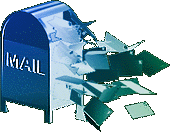| CAGES | PERCHES | TOYS |
| FEATHER JUNCTION INDEX | [ PROMOTIONAL LINKS ] | [ E-MAIL US!! ] |
| Animal Environments
2270 Camino Vida Roble, Ste. 1 Carlsbad, CA, 92009 |
Inglebrook Forges
151 N. San Dimas Canyon Rd. San Dimas, CA, 91773 |
| King's Aviary
256-8 Craft Ave. Rosedale, NY 11422 |
Quisenberry Enterprises
915 Glen Arrow Hwy. Glendora, CA, 91740 |
| The Pet Ranch
This is who I ultimately purchased from: 3015 Pioneer Way Jamul, CA, 91935 (619) 669 - 1089 |
A wrought iron Macaw cage (24 x 36 x 65 inches)
was 249.00 plus 54.29 shipping (from CA to MD, mind you). A Cockatoo cage was 199.00 (don't know shipping) (prices as of 10/14/93). |
| TOP OF PAGE | FEATHER JUNCTION INDEX |
| Aries Manufacturing (Manzanita perches)
4480 Treat Blvd. Ste. 201 Concord, CA, 9421 |
Avian Adventures (acrylic)
Warren, MI, 48902-0136 $2.00 for brochure, refunded with order. |
| TOP OF PAGE | FEATHER JUNCTION INDEX |
| B is for Bird Toy
6740 William Ln Lincoln, CA, 95648 |
Fowl Play
108 Charmont Dr. Radford, VA, 24141 |
| Polly Dolly Texture Toy
P.O. Box 997 Comfort, TX, 78013 |
Thee Birdie Bordello
P.O. Box 2906 El Segundo, CA, 90245 |
| TOP OF PAGE | FEATHER JUNCTION INDEX |

| TOP OF PAGE | FEATHER JUNCTION INDEX |

| TOP OF PAGE | FEATHER JUNCTION INDEX |
